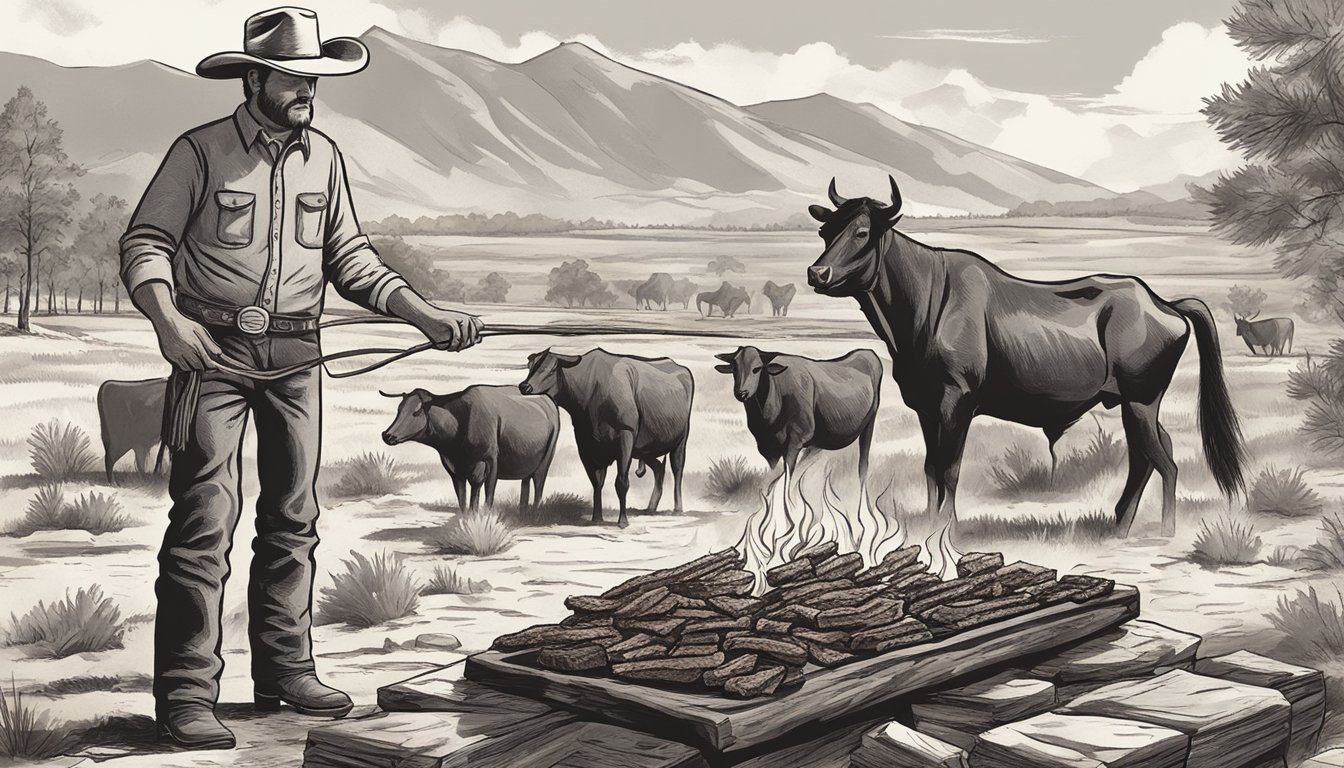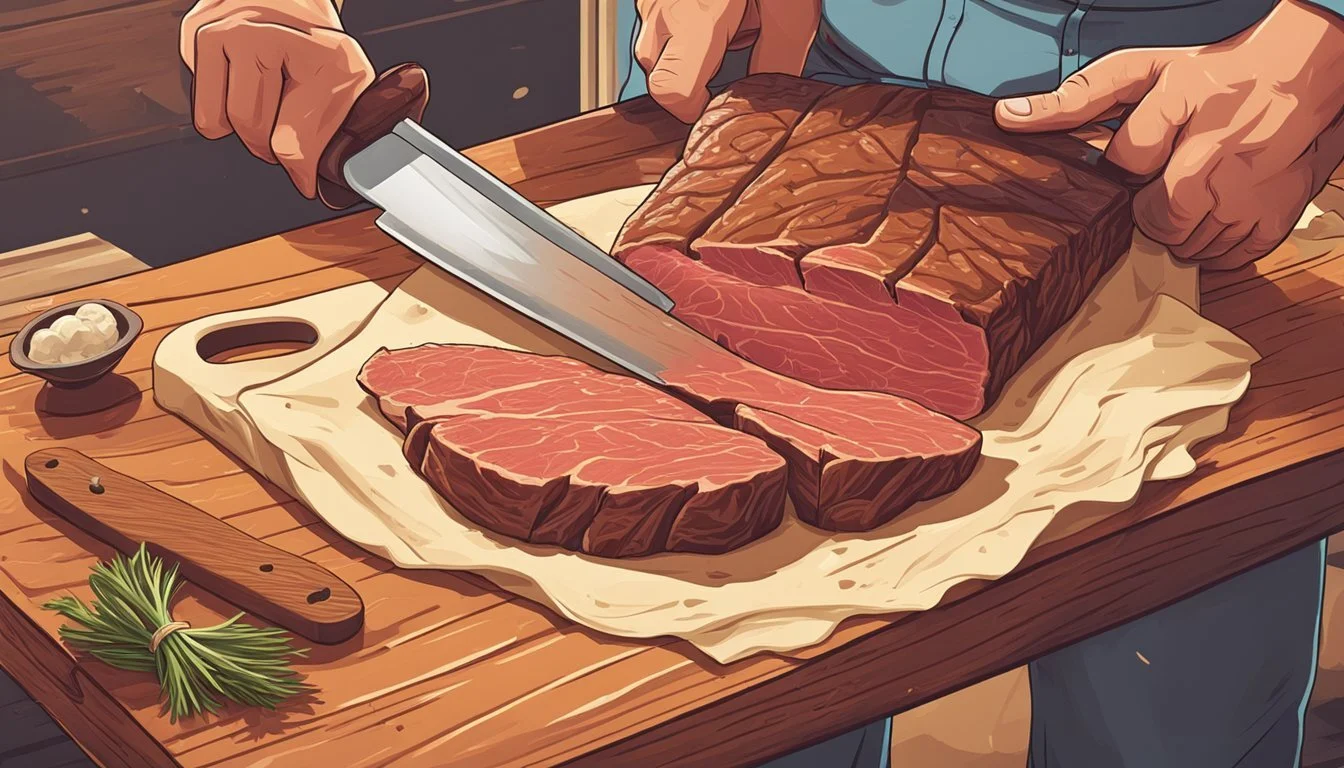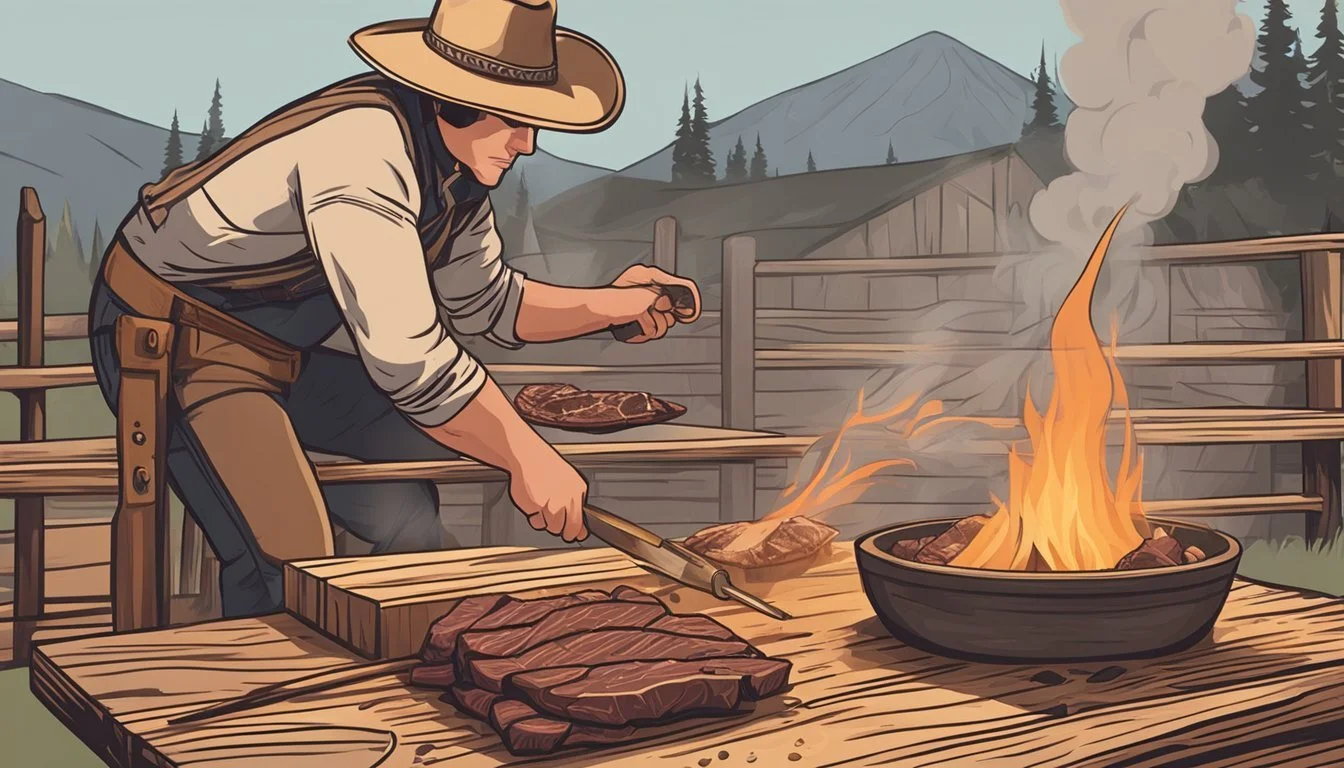The Art of Making Texas-Style Beef Jerky on the Range
Your Ultimate Guide
Texas-style beef (What wine goes well with beef?) jerky is a beloved regional delicacy famed for its robust flavor and unique preparation methods. The art of crafting this savory snack is steeped in tradition, with techniques passed down through generations of jerky aficionados. Factors ranging from the cut of the beef to the smoking process contribute significantly to the final product's taste and texture. Typically, the meat is sliced against the grain to ensure tenderness, and then it is marinated to infuse the signature Texan flavors.
On the range, making beef jerky is more than just a culinary process; it's part of the cultural heritage that resonates with the rustic charm of Texas. The ideal jerky comes from a balance of seasoning, smoking, and drying – a harmonious blend of craft and patience. Smokehouses across Texas are known for their specialty recipes, often involving a variety of spices and smoking woods that give the jerky its distinctive character.
The thrill of enjoying beef jerky goes beyond its taste. It's about the connection to the land and to the traditions of Texan cuisine. Whether it's made on a large-scale or within the confines of a home kitchen, the creation of Texas-style beef jerky carries with it the spirit of the Lone Star State – bold, unapologetic, and deeply rooted in history.
History and Significance of Texas-Style Beef Jerky
Texas-style beef jerky has a robust history intertwined with the state's culture. In Texas, jerky is more than just a snack; it's a reflection of a rich tradition of meat preservation that dates back to the early inhabitants.
Beef jerky arose out of a practical need to preserve meat in the absence of refrigeration. The technique, which involves removing the moisture from meat through drying and adding salt for preservation, was essential for survival. Early Texans adopted these jerking techniques, which allowed them to carry sustenance on long cattle drives without spoilage.
In modern times, what sets Texas-style beef jerky apart is its distinctive flavor profile. It typically has a balance of smokiness, spice, and a slight sweetness, making it a popular item at local gatherings and a reflection of the state's love for bold flavors.
As a part of Texan culture, beef jerky has become a staple. It signifies both the state’s historical roots in cattle rearing and its ongoing tradition of culinary innovation. Jerky's prevalence is marked by its availability at barbecues, picnics, and across a variety of local Texas stores.
The beef jerky industry in Texas has evolved, accommodating both traditional methods and more modern, commercial approaches to production. Yet, the core of what makes Texas-style beef jerky revered remains its connection to the state's past and the enduring legacy of its flavor and practicality.
Selecting the Right Cut
The success of Texas-style beef jerky hinges on selecting an appropriate beef cut. This section guides you through understanding beef anatomy, identifying lean cuts ideal for jerky, and seeking advice from butchers for premium results.
Understanding Beef Cuts
Beef jerky requires cuts with minimal fat to ensure proper drying and preservation. The anatomy of beef cattle provides various cuts, each differing in taste, texture, and suitability for jerky. Lean cuts are paramount, as excess fat can cause the jerky to spoil faster. Key areas like the eye of round, top round, and bottom round—all from the rear leg of the cow—are preferred for their lower fat content.
Lean Cuts for Jerky
Eye of Round: A premier choice found in the bottom sirloin subprimal cut. Its fine texture and lean nature make it an excellent candidate.
Top Round: Slightly more marbled than the eye of round but still lean enough for jerky, yielding a robust flavor.
Bottom Round: Also lean and flavorful, albeit tougher. It offers a good balance between texture and taste.
When preparing these cuts for jerky, one should remove the excess fat and trim any fat cap to further preserve the meat during the jerky-making process.
Butcher's Advice
Consulting with a butcher at a butcher shop can be instrumental. They can provide insights into the freshest cuts of beef suitable for jerky. These professionals can also offer tips on slicing against the grain—essential for achieving the perfect chewiness in jerky. Moreover, butchers can trim the lean cut of beef appropriately, ensuring optimal results for homemade Texas-style beef jerky.
Preparing the Meat
The foundation of Texas-style beef jerky is in how the meat is prepared. Precise trimming, slicing techniques, and attention to texture are paramount for achieving that characteristic chew and flavor.
Trimming the Fat
For optimal preservation and quality, jerky requires lean meat. They begin by selecting a suitable cut, such as the eye of round, then carefully trim away all visible fat with a sharp knife. Fat can cause the jerky to spoil more quickly, so thorough trimming is essential.
Slicing Techniques
A sharp knife is indispensable for cleanly slicing meat. It should be used to slice the meat against or with the grain based on the desired texture. Slicing against the grain results in a tender jerky, while slicing with the grain offers more chewiness. Alternatively, one can employ a jerky slicer for consistent thickness.
Slicing Meat for Even Textures
Jerky excels when each piece has a uniform thickness, typically between 1/8" and 1/4". They may freeze the meat slightly to make it easier to slice uniformly. When sliced thin, the jerky not only dries evenly but also absorbs the marinade effectively, contributing to a balanced texture and robust flavor profile.
Crafting the Marinade
A meticulously crafted marinade is crucial for infusing the beef with rich, robust flavors that are emblematic of Texas-style beef jerky. The choice of ingredients and the marination process play pivotal roles in determining the jerky's final taste.
Marinade Ingredients
For a classic Texas-style jerky marinade, the foundational ingredients typically include:
Soy sauce: for umami and depth.
Worcestershire sauce: adding complexity.
Liquid smoke: to infuse a smoky flavor.
Black pepper: freshly ground for a spicy kick.
Salt: for curing and flavor enhancement.
Additional elements often consist of:
Garlic powder and onion powder: for aromatic undertones.
Brown sugar or honey: to balance with a touch of sweetness.
Hot sauce or vinegar: for tangy heat.
A blend of seasonings to customize the taste profile.
Customizing Flavors
To personalize the marinade, consider the following options:
Boldness: Hot sauce or additional black pepper can elevate the heat.
Sweetness: Modulate by adjusting the brown sugar or honey.
Tanginess: Play with vinegar proportions to influence tang.
Savory depth: Amplify with extra garlic powder or liquid smoke.
Marination Process
The marination process is where flavors are absorbed, making it pivotal for a flavorful jerky. Steps are as follows:
Combine all marinade ingredients in a large bowl.
Submerge the beef strips fully in the marinade.
Cover and refrigerate for at least 4 hours, though ideally overnight.
It's vital that the beef is completely coated and allowed to marinate under refrigeration to ensure maximum flavor absorption while maintaining food safety.
Drying and Dehydrating
Drying and dehydrating beef jerky is crucial for achieving that ideal texture while preserving the meat. Whether one uses a dehydrator, oven, or smoker, the key is to remove moisture effectively while locking in flavor.
Using a Dehydrator
For consistency and ease, a dehydrator is often the tool of choice for making beef jerky. To begin:
Arrange the beef strips on the dehydrator trays, leaving adequate space between them to enhance airflow.
Dehydrate at 165 degrees Fahrenheit until the internal temperature reaches 160 degrees, typically taking about 3 hours, ensuring food safety.
Reduce the heat to 145 degrees and continue dehydrating. Check the jerky after 4 hours; it should bend and crack but not break.
Note: Thinner slices (1/8" to 1/4") may take 3 to 5 hours, while thicker slices (1/2" or more) might require 7 to 10 hours.
Oven-Drying Method
Oven-drying is a practical alternative if a dehydrator is not available:
Preheat your oven to the lowest setting, ideally around 170 degrees Fahrenheit.
Line a baking sheet with foil and place a rack over the sheet to collect any drippings.
Arrange the beef strips on the rack and place them in the oven with the door slightly ajar to allow moisture to escape.
It can take approximately 3 to 8 hours depending on the thickness of the meat and the oven's temperature.
The jerky's readiness is indicated when it is dry to the touch but still pliable.
Smoking for Flavor
Smoking adds a rich layer of flavor, typically using woods like oak, hickory, or apple. To smoke beef jerky:
Preheat the pellet smoker or traditional smoker to about 175 degrees Fahrenheit.
Lay out the meat strips on the smoker racks, ensuring they do not overlap.
Smoke the jerky for about 2 to 4 hours.
The meat should be periodically checked for dryness while smoking, looking for that perfect balance between tough and chewy.
Preserving and Storing
Texas-style beef jerky is a savory treat, prized for its flavor and longevity. Effective preservation and storage are pivotal for maintaining the jerky's quality and extending its shelf life.
Ensuring Proper Storage
Storing beef jerky correctly is crucial to prevent spoilage and maintain its taste. Once the jerky is prepared and dried, it should be placed in a Ziplock bag, vacuum-sealed bag, or airtight container to protect it from humidity and contaminants. For short-term storage, a pantry or cupboard away from direct sunlight suffices. Beef jerky can last up to one month when stored properly at room temperature.
Maximizing Shelf Life
To stretch the shelf life of beef jerky beyond one month, one can refrigerate or freeze it. In the refrigerator, the jerky should be kept at a temperature of 40°F or below, ideally in a vacuum-sealed bag to minimize exposure to air. This method can preserve the jerky for up to six months. When using a freezer, the jerky can last even longer. Freezing beef jerky in vacuum-sealed bags or airtight containers can extend its shelf life to a year or more. It is essential, however, to ensure that the jerky is completely dry before freezing to prevent ice crystal formation that could compromise the texture and flavor.
Storage Method Container Type Expected Shelf Life Pantry Airtight container/Bag Up to 1 month Fridge Vacuum-sealed bag Up to 6 months Freezer Vacuum-sealed bag/Airtight container 1 year or more
By adhering to these storage guidelines, one ensures that Texas-style beef jerky retains its authentic flavor and texture, providing a long-lasting, high-quality snack perfect for the range or home.
Exploring Variations and Flavors
In the realm of Texas-style beef jerky, the variations and flavors available are as vast as the Texas landscape itself. From alternative meats to different regional spices, Texans take pride in crafting a diverse range of jerky with flavors that pack a punch.
Alternative Meats
While beef is the traditional standard for jerky in Texas, alternative meats such as venison (What wine goes well with venison?) offer an exciting twist. Venison jerky brings a gamier taste and lean texture, setting it apart as a specialty for those looking to explore beyond the expected. The key is to maintain the meat's moisture while imbuing it with bold flavors.
Experimenting with Spices
Every jerky brand has its secret blend, often featuring the common denominator of pepper to create spicy jerky, which is a staple in the Texan palate. Home recipes might include a daring mix of smoked paprika, cumin, and a hint of brown sugar to balance the heat. A masterful spice blend is what makes each piece of jerky exceptional and memorable.
Regional Flavor Twists
Different regions of Texas have their own take on what makes the best beef jerky. Central Texas might boast jerky with a smoky barbecue influence, while the Gulf Coast area could incorporate tangier notes reminiscent of southern cooking. Regardless of the location, Texas beef jerky tends to reflect the distinct culinary character of its region.
Safety and Sanitation
Making Texas-style beef jerky involves careful attention to safety and sanitation to ensure a high-quality product that is safe to consume. Proper meat handling and avoiding contamination are crucial processes.
Handling Meat Safely
When working with meat, temperature control is pivotal. Refrigeration should be maintained at 40°F (4°C) or below to inhibit bacterial growth. During preparation, one should:
Trim the beef, cutting away any fat which can become rancid.
Marinate the meat in a chilled environment to keep it out of the bacterial danger zone, between 40°F and 140°F (4°C and 60°C).
Using curing salt containing sodium nitrite plays a dual role in preserving the meat and keeping it safe. It:
Inhibits the growth of bacteria such as Clostridium botulinum.
Imparts a distinctive flavor and color to the jerky.
Avoiding Contamination
Sanitation is critical to prevent cross-contamination. Surfaces and utensils used must be sanitized before and after contact with raw meat. Key steps include:
Washing hands thoroughly with hot, soapy water before and after handling raw meat.
Using bleach solutions (1 tablespoon unscented, liquid chlorine bleach in 1 gallon of water) to sanitize all equipment.
Ensuring the dehydrator or oven used for making jerky reaches an internal temperature sufficient to kill pathogens, as recommended by food safety guidelines.
By following these focused safety and sanitation practices, makers of Texas-style beef jerky can provide a product that is not only flavorful but also safe for consumption.
Cost Considerations
In Texas-style beef jerky making, the choice between homemade and store-bought varieties, as well as the selection of meat cuts, significantly affects cost.
Homemade vs. Store-Bought
Making beef jerky at home can provide cost savings over purchasing pre-made, store-bought options. Homemade beef jerky allows for the selection of less expensive cuts like flank steak, brisket, or eye of round roast, which can be more cost-efficient. Additionally, creating jerky in bulk at home can further reduce the cost per serving compared to the premium prices often associated with artisanal or small-batch jerky found in stores.
Cost-Effective Choices
For those prioritizing cost-effectiveness in their homemade jerky endeavors:
Flank Steak: An affordable option, flank steak strikes a balance between quality and price.
Brisket: When bought whole, brisket can offer savings; trim and slice it for jerky yourself.
Eye of Round Roast: Known for its leanness, this cut provides excellent yield with minimal waste.
When selecting the meat for jerky, one must weigh the upfront cost against the yield and desired quality to determine the most budget-friendly choice.
Final Touches and Presentation
After meticulously preparing Texas-style beef jerky, the final touches and presentation are crucial to enhance its appeal and convey the craft behind it. Whether for gifts, sales, or personal enjoyment, a thoughtful presentation aligns with the quality of the jerky itself.
Packaging for Gifts or Sale
When packaging Texas-style beef jerky, one should consider materials that protect its tenderness and flavor. Vacuum sealing is a common method that extends shelf life and preserves freshness. For a more rustic feel, glass jars or craft paper bags sealed with a custom sticker reflecting the maker's brand can be used. Details such as the inclusion of dessicant packets help maintain dryness, particularly in humid climates.
For gifting or selling, labeling is important. Include the following details on the label:
Product Name: Texas-Style Beef Jerky
Date of Production
Best Before Date
Net Weight
Ingredients List
Serving Suggestions
The presentation of beef jerky when serving directly contributes to the overall eating experience. Texas-style beef jerky, known for its desired level of tenderness, should be displayed in a way that showcases its texture and makes it inviting to eat.
For casual serving, it can be placed on a wooden cutting board alongside slices of cheese and crackers, forming a rustic charcuterie. Alternatively, for more formal occasions, it can be arranged neatly on a ceramic platter, possibly with labels indicating different flavors or spice levels.
In every setting, the key is to let the natural color and texture of the jerky take center stage, allowing guests to appreciate the quality of the meat and the effort put into its preparation.
Conclusion
Crafting Texas-style beef jerky requires confidence in one’s culinary methods and a deep knowledge of traditional smoking techniques. At the heart of this process is a meticulously honed beef jerky recipe, which balances the robust flavors cherished by jerky lovers.
When preparing smoked beef jerky, the selection of meat is paramount. One should opt for high-quality cuts and adhere to the precise thickness recommended for uniform drying. The meat’s preparation sets the stage for the infusion of flavor—marinades steeped in Texas tradition give the jerky its distinctive taste.
Smoking Process:
Maintain a low and even temperature.
Monitor the jerky regularly.
Allow for adequate air circulation.
The competence showcased in the smoking phase brings forth a product with unmatched texture and consistency. An attentive approach ensures that the beef strips are smoked to perfection, melding smoke and seasoning into a harmonious finish.
In conclusion, the artistry of making Texas-style beef jerky on the range is an endeavor that rewards attention to detail and respect for tradition. The result is a satisfying and savory snack that speaks to the rich culinary heritage of Texas.












